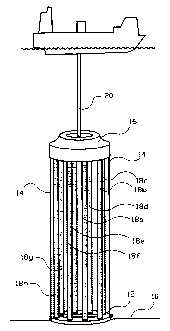Some of the information on this Web page has been provided by external sources. The Government of Canada is not responsible for the accuracy, reliability or currency of the information supplied by external sources. Users wishing to rely upon this information should consult directly with the source of the information. Content provided by external sources is not subject to official languages, privacy and accessibility requirements.
Any discrepancies in the text and image of the Claims and Abstract are due to differing posting times. Text of the Claims and Abstract are posted:
| (12) Patent: | (11) CA 2248683 |
|---|---|
| (54) English Title: | UNDERWATER INSTALLATION AND METHOD FOR BUILDING OF AN UNDERWATER INSTALLATION |
| (54) French Title: | INSTALLATION SOUS-MARINE ET SON PROCEDE DE CONSTRUCTION |
| Status: | Expired and beyond the Period of Reversal |
| (51) International Patent Classification (IPC): |
|
|---|---|
| (72) Inventors : |
|
| (73) Owners : |
|
| (71) Applicants : |
|
| (74) Agent: | MARKS & CLERK |
| (74) Associate agent: | |
| (45) Issued: | 2006-04-18 |
| (86) PCT Filing Date: | 1997-03-07 |
| (87) Open to Public Inspection: | 1997-09-18 |
| Examination requested: | 2001-10-18 |
| Availability of licence: | N/A |
| Dedicated to the Public: | N/A |
| (25) Language of filing: | English |
| Patent Cooperation Treaty (PCT): | Yes |
|---|---|
| (86) PCT Filing Number: | PCT/NO1997/000068 |
| (87) International Publication Number: | WO 1997034074 |
| (85) National Entry: | 1998-09-10 |
| (30) Application Priority Data: | ||||||
|---|---|---|---|---|---|---|
|
An underwater installation for use in offshore drilling of and production
from,
respectively, oil and/or gas wells at deep and moderate deep water comprises
an
intermediate station in the form of a buoyancy based hollow body (16) tension
strut
anchored at the seabed (10) and located at a depth substantially closer to the
surface
of the sea than the seabed (10). At least one hydrocarbon conveying pipeline
extends
between the buoyancy body (16) and seabed depth, for the transfer of
hydrocarbons from
the reservoir to said buoyancy body (16). At least one casing liner string
(18a-18h)
constitutes the tension leg/strut anchoring of the buoyancy body (16). The
invention
also relates to a method for the building of an underwater installation.
Installation sous-marine à utiliser dans le forage offshore et l'exploitation, respectivement, de puits de pétrole en eau profonde et moyennement profonde. Ladite installation comporte une station intermédiaire se présentant sous la forme de jambes de force d'un corps creux flottant (16), ancrées dans le fond marin (10) et situées à une profondeur sensiblement plus proche de la surface de la mer que du fond (10). Au moins un pipeline de transport d'hydrocarbures s'étend entre le corps flottant (16) et le fond marin pour le transfert d'hydrocarbures depuis le réservoir jusqu'audit corps flottant (16). Au moins un train de chemises du tubage (18a-18h) constitue l'ancrage formant jambe de force du corps flottant (16). L'invention concerne aussi un procédé de construction d'une installation sous-marine.
Note: Claims are shown in the official language in which they were submitted.
Note: Descriptions are shown in the official language in which they were submitted.

2024-08-01:As part of the Next Generation Patents (NGP) transition, the Canadian Patents Database (CPD) now contains a more detailed Event History, which replicates the Event Log of our new back-office solution.
Please note that "Inactive:" events refers to events no longer in use in our new back-office solution.
For a clearer understanding of the status of the application/patent presented on this page, the site Disclaimer , as well as the definitions for Patent , Event History , Maintenance Fee and Payment History should be consulted.
| Description | Date |
|---|---|
| Time Limit for Reversal Expired | 2017-03-07 |
| Letter Sent | 2016-03-07 |
| Letter Sent | 2013-05-22 |
| Inactive: Single transfer | 2013-05-02 |
| Letter Sent | 2006-10-16 |
| Inactive: Single transfer | 2006-09-11 |
| Grant by Issuance | 2006-04-18 |
| Inactive: Cover page published | 2006-04-17 |
| Inactive: IPC from MCD | 2006-03-12 |
| Inactive: IPC from MCD | 2006-03-12 |
| Inactive: IPC from MCD | 2006-03-12 |
| Pre-grant | 2006-02-02 |
| Inactive: Final fee received | 2006-02-02 |
| Notice of Allowance is Issued | 2005-09-07 |
| Letter Sent | 2005-09-07 |
| Notice of Allowance is Issued | 2005-09-07 |
| Inactive: Approved for allowance (AFA) | 2005-08-30 |
| Amendment Received - Voluntary Amendment | 2005-06-03 |
| Inactive: S.30(2) Rules - Examiner requisition | 2005-04-28 |
| Amendment Received - Voluntary Amendment | 2004-09-08 |
| Inactive: S.30(2) Rules - Examiner requisition | 2004-03-09 |
| Inactive: S.29 Rules - Examiner requisition | 2004-03-09 |
| Amendment Received - Voluntary Amendment | 2002-01-31 |
| Letter Sent | 2001-11-21 |
| All Requirements for Examination Determined Compliant | 2001-10-18 |
| Request for Examination Requirements Determined Compliant | 2001-10-18 |
| Request for Examination Received | 2001-10-18 |
| Inactive: IPC assigned | 1998-11-24 |
| Classification Modified | 1998-11-24 |
| Inactive: First IPC assigned | 1998-11-24 |
| Inactive: Notice - National entry - No RFE | 1998-11-10 |
| Application Received - PCT | 1998-11-06 |
| Application Published (Open to Public Inspection) | 1997-09-18 |
There is no abandonment history.
The last payment was received on 2006-01-26
Note : If the full payment has not been received on or before the date indicated, a further fee may be required which may be one of the following
Please refer to the CIPO Patent Fees web page to see all current fee amounts.
Note: Records showing the ownership history in alphabetical order.
| Current Owners on Record |
|---|
| MEPS-FIRST OIL LTD. |
| Past Owners on Record |
|---|
| TERJE MAGNUSSEN |